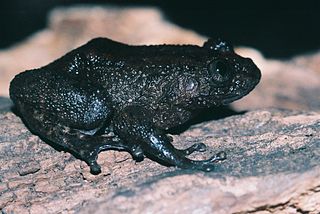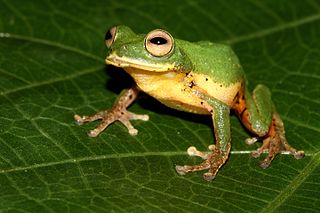
The purple frog, Indian purple frog, or pignose frog is a frog species of the genus Nasikabatrachus. It is endemic to the Western Ghats in India. Although the adult frog was formally described in October 2003, the juvenile form of the species was described earlier in 1917.

The Rhacophoridae are a family of frogs in tropical sub-Saharan Africa, South India and Sri Lanka, Japan, northeastern India to eastern China and Taiwan, south through the Philippines and Greater Sundas, and Sulawesi. They are commonly known as shrub frogs, or more ambiguously as "moss frogs" or "bush frogs". Some Rhacophoridae are called "tree frogs". Among the most spectacular members of this family are numerous "flying frogs".

The Rhacophorinae are a subfamily of frogs in the family Rhacophoridae. They range from tropical Africa and Asia to temperate China and Japan.

Nyctibatrachus is a genus of frogs endemic to the Western Ghats of southwestern India. Their common name is night frogs. Their scientific name also means "night frog", in reference to their habits and dark color. They are the only extant members of the monotypic subfamily Nyctibatrachinae. Currently, 35 species belong to Nyctibatrachus.

Raorchestes flaviventris is a species of arboreal, nocturnal, frog of the family Rhacophoridae. It is endemic to the Western Ghats, South India. Its common names are yellow-bellied bush frog and Malabar bubble-nest frog.

Raorchestes glandulosus, also known as glandular bush frog, rough-skinned bush frog, southern bubble-nest frog, and with many other names, is a species of frog in the family Rhacophoridae. It is endemic to the Western Ghats, India, and known from the states of Karnataka and Kerala.

Raorchestes griet is a species of frog in the family Rhacophoridae. It is endemic to the Western Ghats south of the Palghat Gap in Kerala and Tamil Nadu states, India. The specific name griet honours Griet Decock, spouse of Franky Bossuyt, the scientist who described the species. The common name Griet bush frog has been coined for it.

Raorchestes ponmudi is a species of frog in the family Rhacophoridae. It is endemic to the Western Ghats, India.

Raorchestes travancoricus, variously known as the Travancore bushfrog, Travancore bubble-nest frog, or Travancore tree frog, is a species of frog in the family Rhacophoridae. The species is endemic to the southern Western Ghats, India. Its specific name, travancoricus, as well as its three common names, refer to its type locality, Bodinayakkanur in the former Travancore state.

Ghatixalus variabilis is a species of frog in the family Rhacophoridae. It is endemic to the Western Ghats of southern India. It has a number of common names, including green tree frog, though it is terrestrial rather than arboreal in its life style.

Raorchestes anili, known commonly as Anil's bush frog, is a species of frog in the family Rhacophoridae.

Raorchestes dubois or the Koadaikanal bush frog is a species of frog in the family Rhacophoridae.

Raorchestes is a genus of frogs in the subfamily Rhacophorinae that are found in mountainous regions of South Asia, Southeast Asia, and southern China. A recent study places Raorchestes as a sister taxon of Pseudophilautus. Before the description of the genus in 2010, species now in Raorchestes had been assigned to genera Ixalus, Philautus, and Pseudophilautus.

Raorchestes akroparallagi is a species of frogs in the family Rhacophoridae.

Ghatixalus is a genus of frogs in the family Rhacophoridae, subfamily Rhacophorinae. They are endemic to the Western Ghats of southern India. They are the sister taxon to a larger clade consisting of Chiromantis, Feihyla, Taruga, Polypedates, and Rhacophorus. The name of the genus combines words "Ghats" and "Ixalus". The former refers to the Western Ghats, and the latter to now-abandoned genus name that lives as the suffix in many generic names for rhacophorid frogs.

Raorchestes manohari is a species of frog of the genus Raorchestes found in Bonacaud in the Western Ghats of Kerala in India. The species is named after T. M. Manoharan, Principal Chief Conservator of Forests, Kerala.
Raorchestes kollimalai, the Kollimalai bush frog, is a species of frog in the family Rhacophoridae. It is endemic to India. Scientists have observed it its type locality in the Western Ghat mountains, about 1100 meters above sea level.
Raorchestes hillisi is a species of frog in the family Rhacophoridae. It is endemic to China. Scientists have observed it 1719 meters above sea level.
Ghatixalus magnus, the large-sized Ghat tree frog, is a species of frog in the subfamily Rhacophorinae. It is endemic to India, in the southern Western Ghat mountains, between the Palakkad Gap and Shencottah Gap.
Indirana paramakri, the rocky terrain leaping frog or Suganthagiri leaping frog, is a frog in the family Ranixalidae. It is endemic to Kerala, India in the Western Ghat mountains.

















